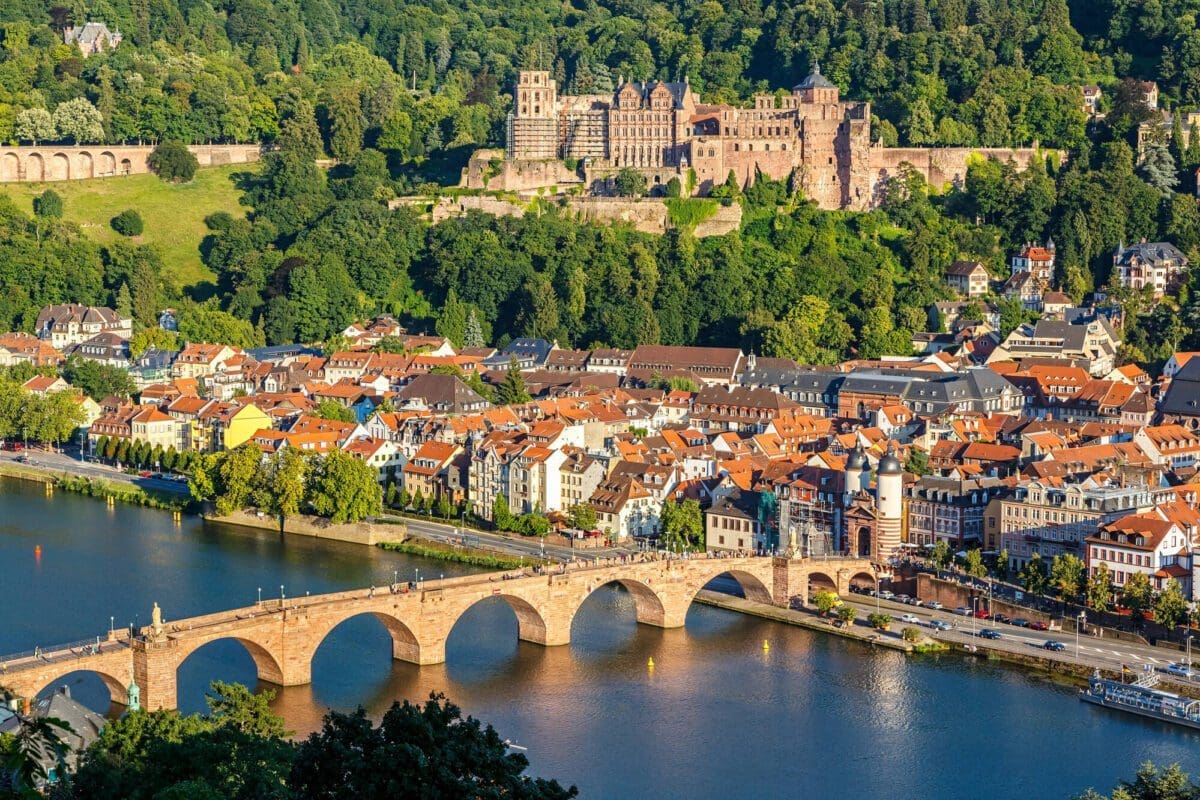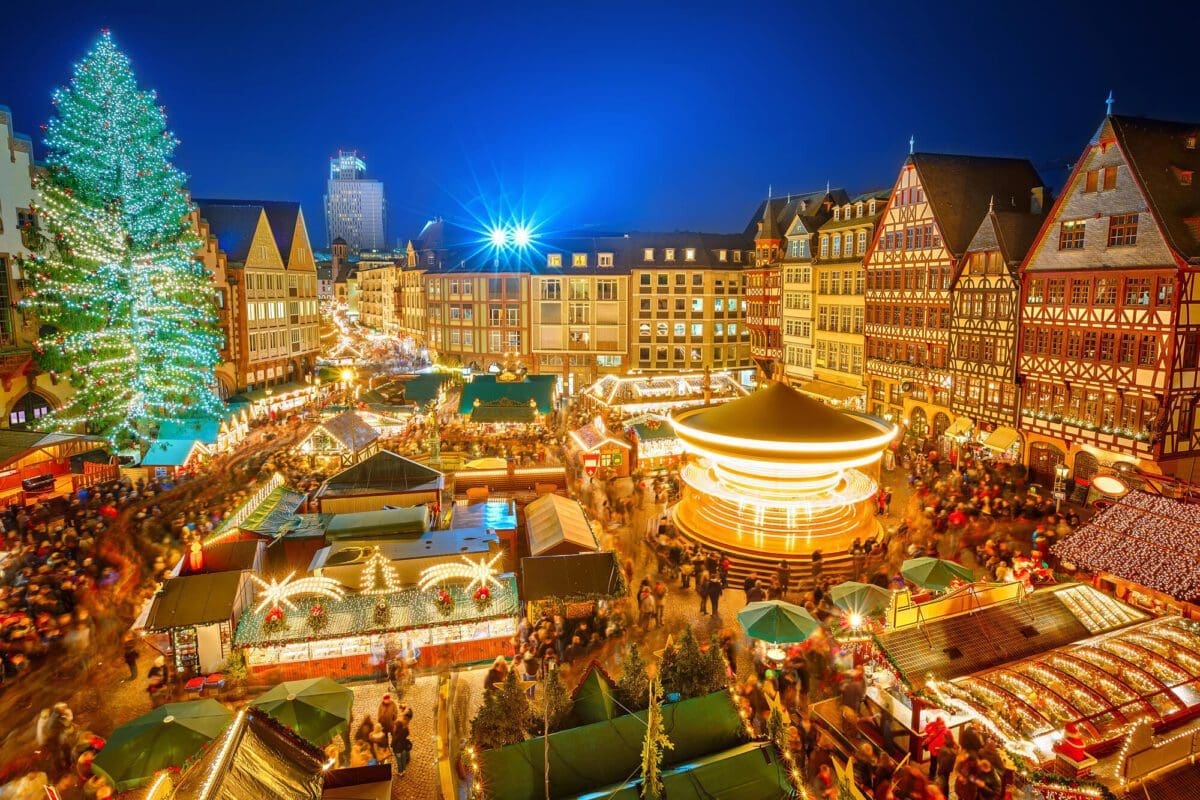Updated
If you love historic European cities with a romantic riverbend and a castle crowning the skyline, Heidelberg belongs on your itinerary. Backed by the wooded Odenwald hills and straddling the Neckar River, the city blends storybook scenery with one of Europe’s oldest universities, lively cafés, and a walkable Old Town that still wears its baroque facades with pride.
Heidelberg is famous for its red sandstone castle ruin, classic views from the Old Bridge, and the Philosophers’ Walk, but fame is only half the story. This is a living city with students on bikes, wine taverns humming after dark, and weekend markets spilling into sunlit squares. Visit for a day and you’ll understand the allure. Stay a night or two and Heidelberg opens up in layers—quieter lanes, golden light on the castle walls, a boat sliding under the arches of the bridge at dusk.
Short answer: Is Heidelberg worth visiting? Absolutely—whether you’re on a quick day trip from Frankfurt or Stuttgart or looking for a relaxed weekend, Heidelberg delivers history, scenery, and local flavor in a compact, easygoing package.
Table of Contents
Where is Heidelberg and how do you get there?

By air
- Frankfurt Airport (FRA): The closest major gateway, roughly 79 km/49 miles away. From the airport’s rail stations (Regionalbahnhof and Fernbahnhof), Heidelberg is typically 45–60 minutes by train, usually with a quick change in Mannheim. Direct intercity buses also run from FRA to Heidelberg.
- Stuttgart Airport (STR): Around 124 km/77 miles. Door-to-door travel usually takes 1.5–2 hours by train with a change in Mannheim, or by car depending on traffic.
By train
- Frankfurt (Main) Hbf to Heidelberg: Around 55–70 minutes, many services with a same-platform change in Mannheim.
- Stuttgart to Heidelberg: About 1.5 hours by train, usually via Mannheim.
- Munich to Heidelberg: Just under 3 hours on direct ICE/IC services.
- Berlin to Heidelberg: Just under 6 hours on direct services; faster combinations are possible with one change.
- Money-saving tip: If your travel relies on regional trains (RB/RE/S-Bahn), consider the nationwide monthly regional pass (Deutschlandticket). Check current price and validity before you go.
By car
- FRA to Heidelberg: Around 1 hour (90 km/56 miles).
- Stuttgart to Heidelberg: Around 1.5 hours (126 km/78 miles).
- Nuremberg to Heidelberg: Around 2 hours (230 km/143 miles).
- Practical tip: Trains are often faster and easier. If you drive, pre-program a public garage (Parkhaus) in the Old Town; access is restricted and streets are tight. Park & Ride options exist on the city edges.
Orientation essentials
- The castle sits on the slope of the Königstuhl above the south bank.
- The Old Town stretches along the south bank’s Hauptstraße and side lanes.
- The Old Bridge (Karl-Theodor-Brücke) links the Old Town to the North Bank and Philosophenweg trailheads.
- The train station (Hauptbahnhof) lies west of the Old Town; trams/buses connect quickly, and you can walk to the Altstadt in about 20–25 minutes.
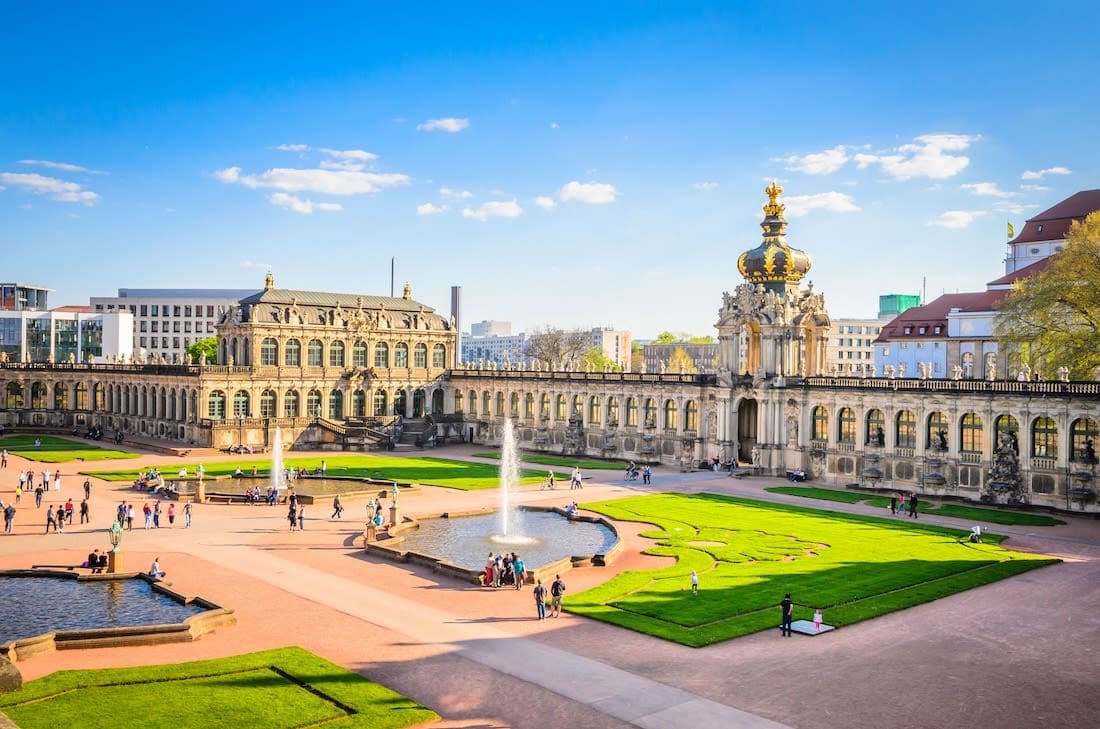
Want to build your own trip to Heidelberg instead?
Instantly create your own customized trip with our easy to use trip builder
The 10 reasons Heidelberg is worth visiting
Discover all Heidelberg tours and itineraries
1. Old Town Heidelberg’s Altstadt
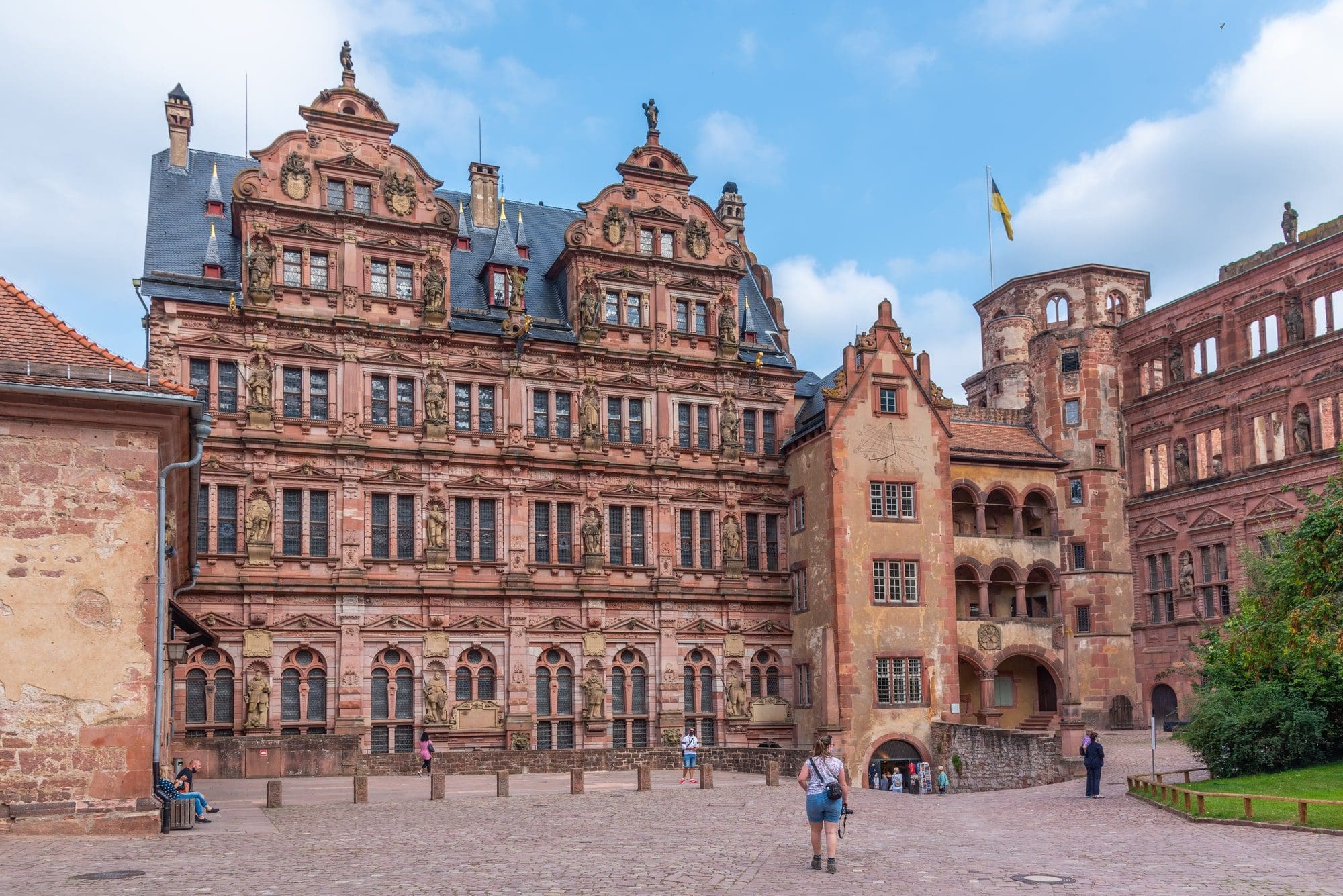
A storybook setting and a rare, intact Old Town Heidelberg’s Altstadt is one of Germany’s most evocative Old Towns—cobbled lanes, church spires, baroque facades, and a river spanned by an elegant stone bridge. Much of this charm survives because the city was largely spared the destruction that reshaped so many German centers in WWII. The regular, handsome streets you see today reflect a baroque rebuild after fires and attacks in the late 17th century (notably during the Nine Years’ War), giving Heidelberg an unusually uniform historic look.
Stroll the Hauptstraße, one of Europe’s longest pedestrian streets. Linger in Marktplatz by the Church of the Holy Spirit. Wander the Jesuit Quarter and detour into quieter lanes where painted doorframes and ivy-draped courtyards feel like small discoveries. Down on the river, cross the Old Bridge, say hello to the whimsical bronze monkey statue at its southern end, and take in that postcard view: bridge arches, red roofs, the castle rising above forests.
Highlights to seek out in the Old Town:
- Marktplatz and Kornmarkt: Squares perfect for markets, coffee breaks, and those first castle views.
- Heiliggeistkirche (Church of the Holy Spirit): A landmark you’ll navigate by all day.
- Jesuitenkirche (Jesuit Church) and the Jesuit Quarter: Baroque architecture and calm streets.
- Old Bridge (Karl-Theodor-Brücke): With its gate towers and figurines, it’s a quintessential Heidelberg moment.
- The Bridge Monkey: A playful local icon; touch the mirror for “luck,” a lighthearted tradition for photos.
Also Read: How to plan your Germany trip Step-by-Step Guide
2. Iconic viewpoints
Iconic viewpoints—Philosophers’ Walk and Königstuhl Heidelberg’s best panoramas are easy to reach. Cross the Old Bridge and climb onto the Heiligenberg slope on the north bank for the Philosophenweg (Philosophers’ Walk). In this sunny microclimate, Mediterranean plants—from figs to almonds—thrive along garden walls. The Philosophengärtchen (Philosophers’ Garden) is the classic vantage point: castle, bridge, red roofs, church spires, and forested hills arrayed like a model city.
Options from the north bank:
- Short, steep access paths: Well-signed from the bridgehead; expect steps and a bit of a workout.
- Extend your hike: Continue up toward the ruins of St. Michael’s Monastery and the open-air amphitheater (Thingstätte) to weave in archaeology, 20th-century history, and more woodland.
- Light and timing: Morning light favors the Philosophenweg for a softly lit Old Town; late afternoon/early evening brings glow to the castle walls, especially in summer.
Königstuhl—the city’s high point:
- Ride the upper historic funicular from Molkenkur to Königstuhl for broad views across the Rhine lowlands and into the Palatinate on clear days.
- Trails crisscross the forests from the summit; an excellent choice if you want to put a few quiet kilometers underfoot.
- Astronomy-minded travelers will note the Königstuhl State Observatory and the Max Planck Institute for Astronomy on the hill. Public access varies, and the funicular does not typically run late at night, so plan your return by foot or taxi if you stay after dark.
3. Heidelberg Castle
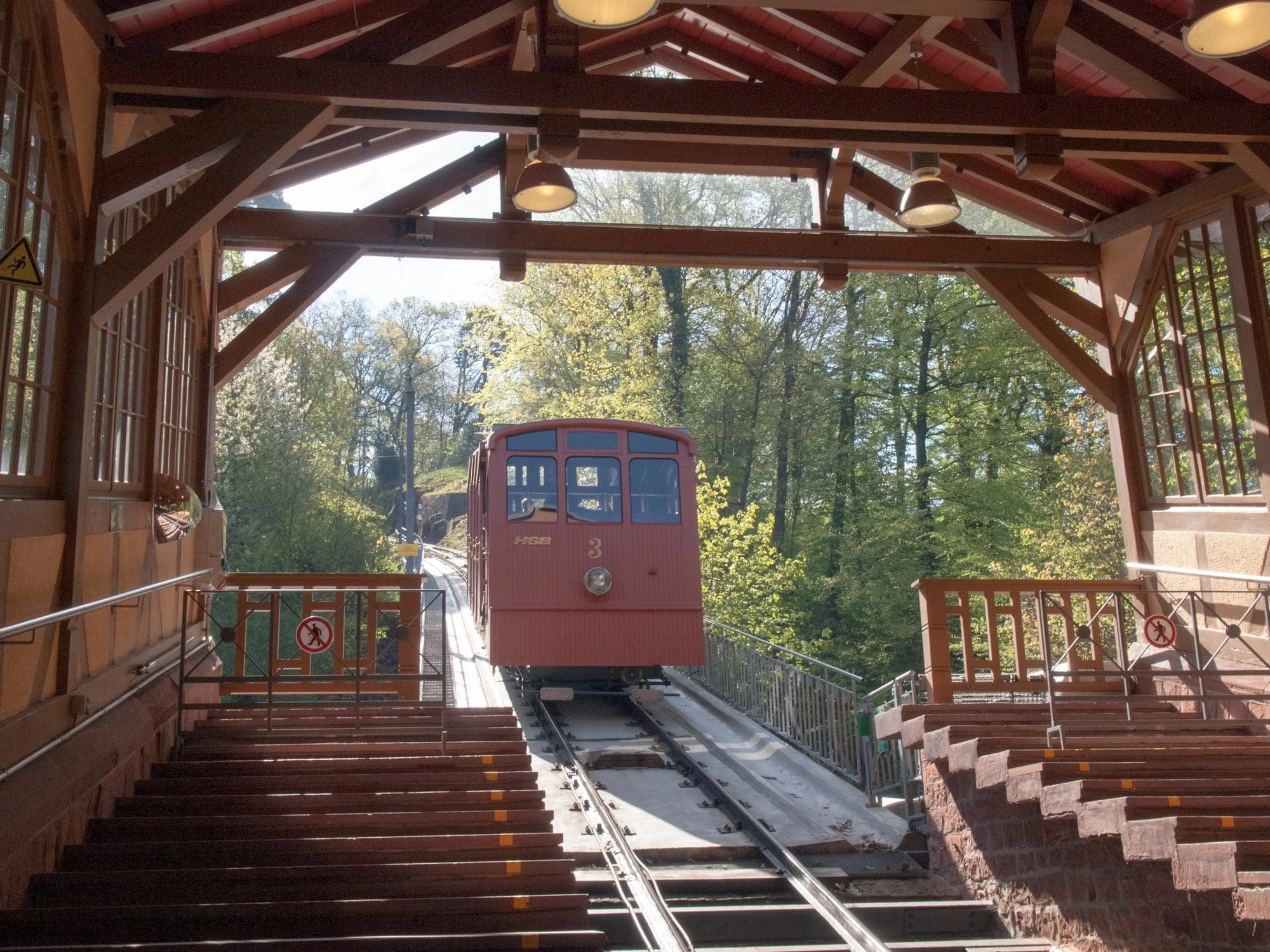
Heidelberg Castle—romance and history on a hill Few European castles cast a spell like Heidelberg’s. The red sandstone ruin—really a sprawling complex of palaces, towers, gates, and terraces—sits about 80 meters above the river, with panoramic views over rooftops and the Neckar valley. Renaissance facades bear scars from wars that once shook the Palatinate; ivy crawls over walls; gardens terrace the hillside.
What you’ll see:
- Castle courtyard and terraces: Sweeping views and intricate Renaissance stonework.
- The Great Barrel (Großes Fass): A vast wine cask that points to the Electors Palatine’s taste for spectacle.
- The German Pharmacy Museum (Deutsches Apotheken-Museum): A surprisingly engrossing collection of apothecary shops, jars, instruments, and medical curiosities through the ages.
How to visit:
- Funicular (Heidelberger Bergbahn): From Kornmarkt in the Old Town, the lower line takes you up to Schloss (castle) and Molkenkur stations. A “castle ticket” usually includes the lower funicular to Schloss plus access to the castle courtyard, the Great Barrel, and the Pharmacy Museum. For the summit (Königstuhl), you’ll need an extended ticket that includes the upper historic line from Molkenkur to the top. Check current fares and operating times on the official site (bergbahn-heidelberg.de).
- Walking up: A steep but rewarding hike via the Burgweg offers changing views and quiet corners.
- Guided tours: If available, tours add context about the Electors Palatine, the Renaissance court, and the wars (including the Thirty Years’ War and Nine Years’ War) that shaped the castle’s fate.
Timing and tips:
- Go early or late in the day to enjoy gentler light and thinner crowds.
- Combine an uphill funicular ride with a walk back down through the gardens.
- If you’re into photography, late afternoon light often fires the red stone into a warm glow.
For a better understanding of the funicular prices, you can check out: Funicular travel ticket including admission to the castle (bergbahn-heidelberg.de).
Read More: 15 Most Beautiful villages in Germany you should visit once
4. Ruprecht-Karls-Universität
Germany’s oldest university and quirky student traditions Ruprecht-Karls-Universität, founded in 1386, infuses Heidelberg with a buzz few historic towns can match. Students bring energy to cafés, bookshops, taverns, and riverside lawns; academic buildings peek from behind baroque facades.
Don’t miss:
- The Studentenkarzer (Student Prison): In use from the 18th to early 20th centuries, it “detained” misbehaving students in a space they famously decorated with graffiti and paintings—irreverent and oddly touching. It’s a snapshot of student life across centuries. Check opening hours via the University Museum or Heidelberg Marketing sites before you go.
- The University Museum: Exhibits on the university’s history and the intellectual life of the city.
- Old lecture halls and courtyards: Access varies; keep an eye out for temporary exhibitions that open otherwise closed spaces.
Why it matters:
- Heidelberg’s scholarly and literary heritage—spanning philosophers, poets, and scientists—adds layers to your visit, from bookish cafés to the tone of the town’s nightlife. It’s as much a place of ideas as it is of photo ops.
5. A Gateway to the Black Forest
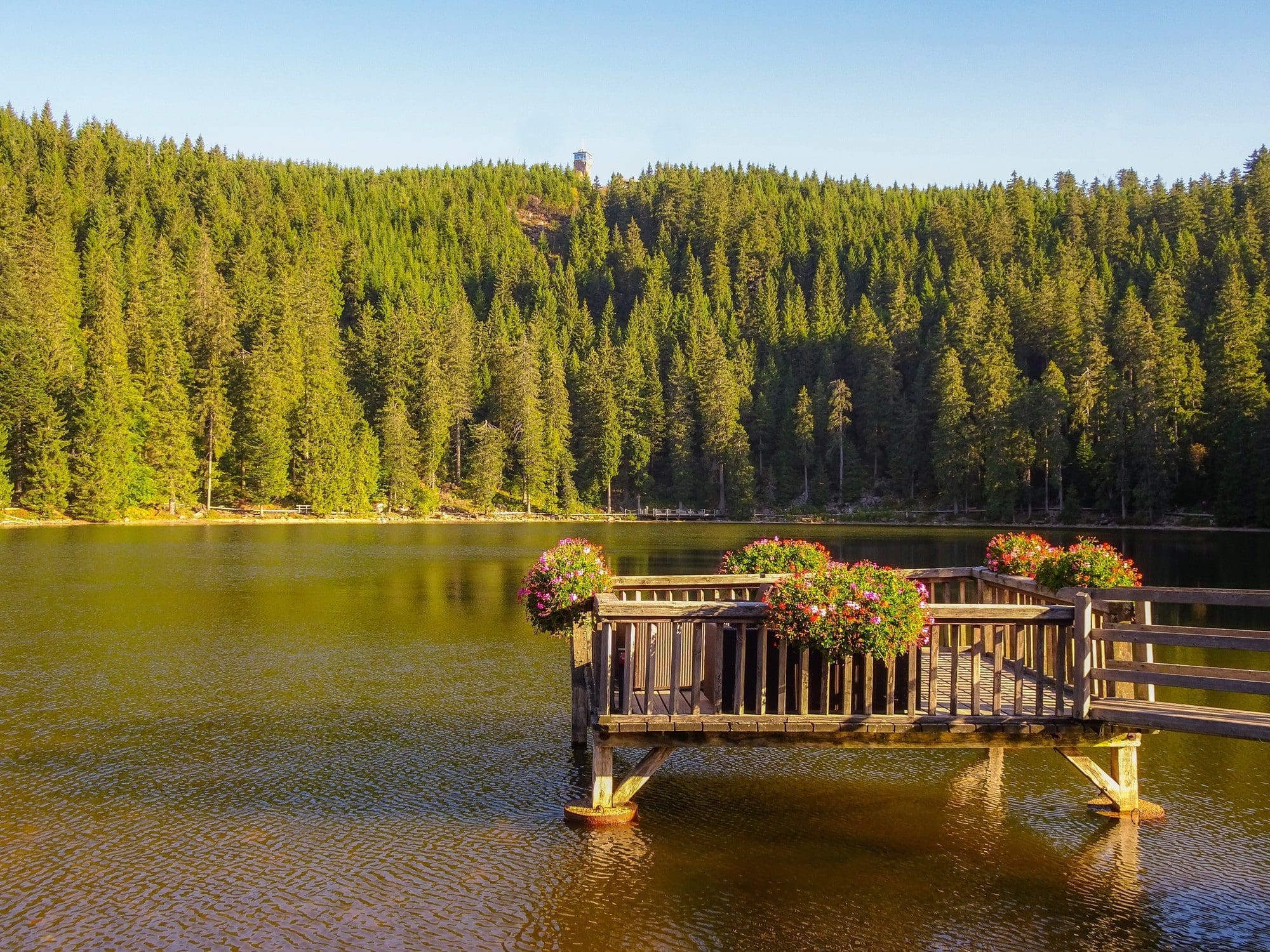
Your gateway to forests, wine country, and easy day trips Heidelberg is perfectly placed for deep dives into the region’s natural and cultural riches.
Close and classic:
- Schwetzingen Palace and Gardens (12 km): A baroque gem with playful garden architecture. It’s exquisite in spring and early summer when the grounds are lush.
- Ladenburg (15 km): Roman roots, half-timbered houses, and a slower pace along the Neckar.
- Speyer (40 km): A UNESCO-listed Romanesque cathedral, one of Europe’s great medieval churches, plus an excellent technology museum.
- Maulbronn Monastery (65 km): A UNESCO-listed Cistercian abbey complex that’s astonishingly intact.
Nature and wine:
- Odenwald hills: Forest trails, castle ruins, and village hikes start within the city’s orbit. Trails up the Königstuhl or Heiligenberg reward you with views and peace.
- The Palatinate Wine Route: Deidesheim, Bad Dürkheim, and neighboring villages offer cozy taverns, vineyard walks, and wine tastings among rolling hills.
- Northern Black Forest: In about 60–90 minutes by car you can be on the Schwarzwaldhochstraße (B500), at Mummelsee beneath Hornisgrinde, or on a spruce-scented trail with Rhine Valley views. It’s a big day out from Heidelberg and easy to build into a longer regional loop.
6. RomantiC Heidelberg
Perfect for couples—and anyone who loves romance Heidelberg has been inspiring poets and painters for centuries, and it’s easy to see why. A castle ruin that glows at sunset, lamplit lanes, and hilltop viewpoints with room to pause—this is a city made for unhurried wandering.
Couples’ checklist:
- Sunset on the Philosophenweg: Bring a bottle (and a corkscrew) for a low-key toast over the rooftops.
- Old Bridge stroll: Catch the castle illumination reflected on the river after dark.
- Cozy dinner in a wood-paneled tavern: Local dishes and wines from nearby Baden and Palatinate regions make for a perfect evening.
- Stay overnight: Once day-trippers leave, the Altstadt hushes and the castle lights up. If you’re thinking anniversary weekend or even a proposal, Heidelberg checks every box.
Explore Heidelberg on our 10-Day Paris Germany itinerary
7. Vibrant Nightlife
Food, wine, and beer—regional flavors in characterful spaces Heidelberg isn’t about flashy restaurants; it’s about convivial taverns, beer brewed a few doors away, cake and coffee, and terroir-driven wines from two powerhouse regions (Baden and the Palatinate) on your doorstep.
What to eat and drink:
- Classics: Flammkuchen (Alsatian-style flatbread), Maultaschen (Swabian stuffed pasta), schnitzels, and hearty roasts in winter.
- Local beer: Vetter’s Alt Heidelberger Brauhaus on the Untere Straße is a beloved institution. Their Vetter 33 is legendary for its original wort of 33° Plato and a formidable ABV around 11–12%. It’s strong, storied, and worth a measured sip.
- Brewpubs: Kulturbrauerei Heidelberg pairs house beers with seasonal German dishes in a handsome setting.
- Wine taverns (Weinstuben): Sample crisp Rieslings and elegant Spätburgunders (Pinot Noir) from the Palatinate and Baden in intimate spaces.
- Sweet tradition: Café Knösel’s “Studentenkuss” chocolates—little kisses that have been fueling flirtations and souvenir boxes since the 19th century.
Budget-friendly tips:
- Breakfast at a bakery: Fresh rolls, pastries, and coffee are an easy, delicious way to start the day.
- Lunch specials: Many places offer set menus midday, making it the best time for a sit-down meal.
- Casual taverns > fine dining: You’ll find more authenticity and better value in simple, convivial spots.
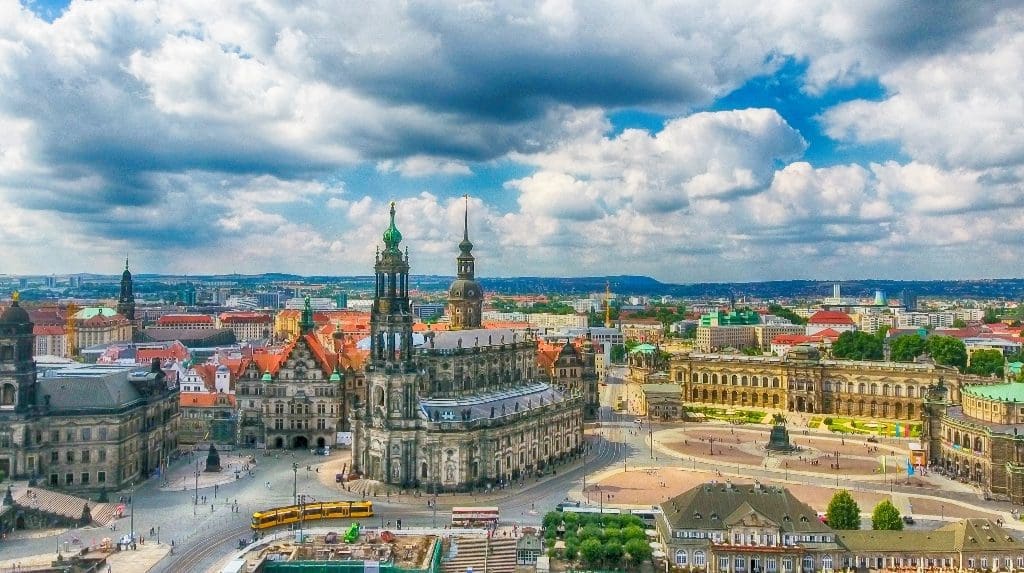
Want to build your own trip to Germany instead?
Instantly create your own customized trip with our easy to use trip builder
8. Magical Christmas Markets
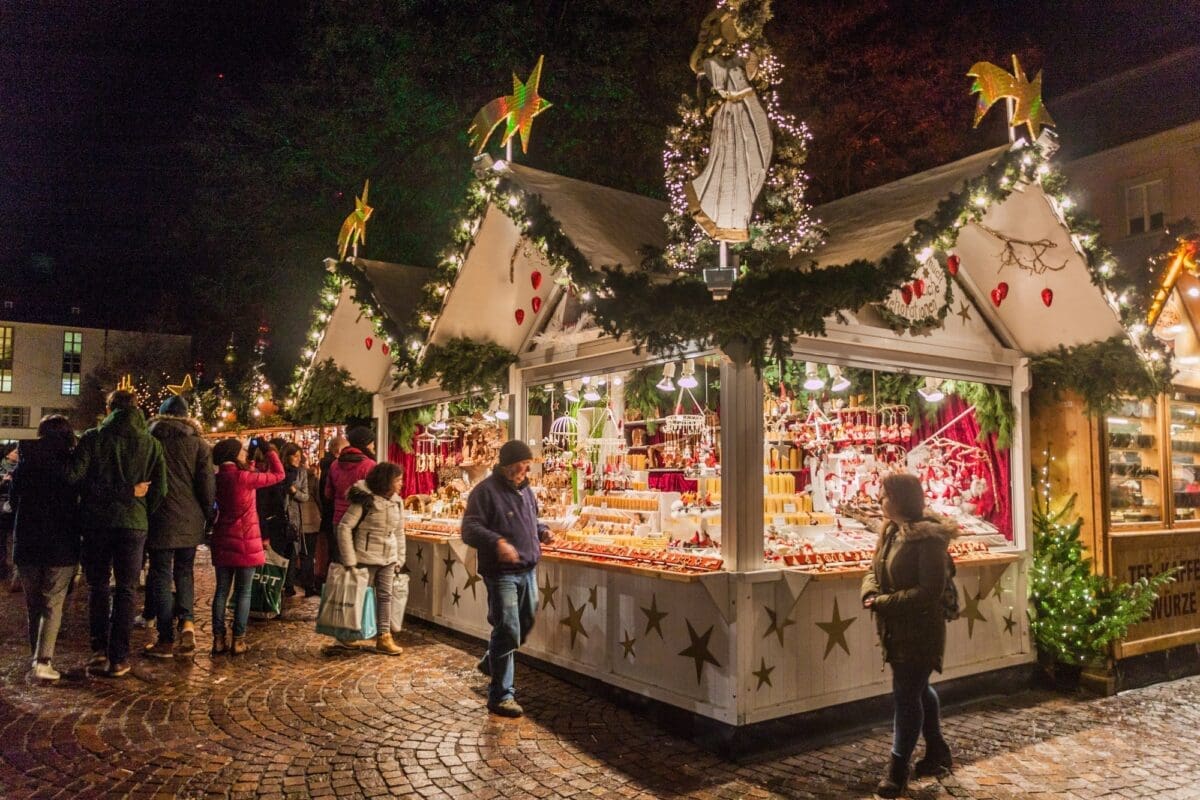
Festivals, fireworks, and magical Christmas markets Heidelberg’s calendar is packed with events that match the city’s romantic vibe.
Seasonal highlights:
- Heidelberger Frühling (Spring Music Festival): March–April, with world-class classical concerts drawing international talent. Booking ahead is essential for headline performances.
- Heidelberg Castle Festival (Schlossfestspiele): Summer theater and concerts unfold in the castle’s evocative courtyards and terraces—one of Europe’s most atmospheric outdoor stages.
- Castle Illuminations and Fireworks: On select Saturday nights from late spring into early fall, the castle is bathed in red light and fireworks bloom over the river. Expect crowds; arrive early and consider watching from the north bank for space and reflections.
- Heidelberger Herbst (Autumn Fair): A lively one-day celebration of food, music, and market stalls with the whole city as backdrop—expect packed streets and a festive buzz.
- Christmas Markets: Multiple markets fill squares across the Old Town—Universitätsplatz, Marktplatz, and the forest-like “Winterwäldchen” on Kornmarkt—against the drama of the castle above. Warm your hands on mulled wine, browse craft stalls, and lace up skates if the seasonal rink returns. Dates usually run late November to just before Christmas; verify current-year details on the official city site (heidelberg-marketing.de).
To make it easier for you, here is a website on the Christmas market with information about the dates and venue: Heidelberg Christmas Market (heidelberg-marketing.de).
Discover Heidelberg on the 3-week Epic all around Germany tour
9. Boat Trip on the Neckar River
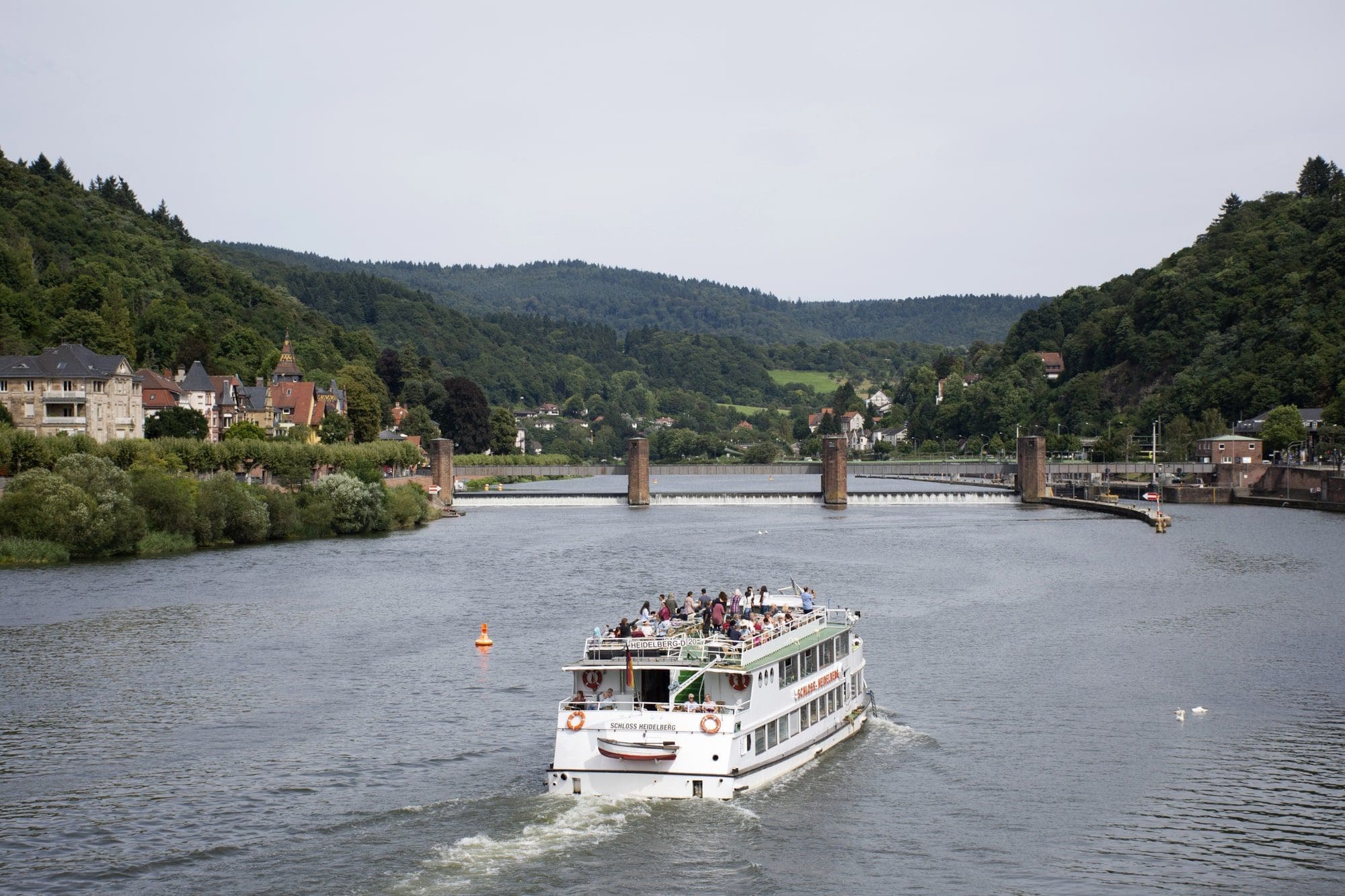
Your gateway to forests, wine country, and easy day trips Heidelberg is perfectly placed for deep dives into the region’s natural and cultural riches.
Close and classic:
- Schwetzingen Palace and Gardens (12 km): A baroque gem with playful garden architecture. It’s exquisite in spring and early summer when the grounds are lush.
- Ladenburg (15 km): Roman roots, half-timbered houses, and a slower pace along the Neckar.
- Speyer (40 km): A UNESCO-listed Romanesque cathedral, one of Europe’s great medieval churches, plus an excellent technology museum.
- Maulbronn Monastery (65 km): A UNESCO-listed Cistercian abbey complex that’s astonishingly intact.
Nature and wine:
- Odenwald hills: Forest trails, castle ruins, and village hikes start within the city’s orbit. Trails up the Königstuhl or Heiligenberg reward you with views and peace.
- The Palatinate Wine Route: Deidesheim, Bad Dürkheim, and neighboring villages offer cozy taverns, vineyard walks, and wine tastings among rolling hills.
- Northern Black Forest: In about 60–90 minutes by car you can be on the Schwarzwaldhochstraße (B500), at Mummelsee beneath Hornisgrinde, or on a spruce-scented trail with Rhine Valley views. It’s a big day out from Heidelberg and easy to build into a longer regional loop.
You can buy tickets online for the cruise here: Shipping & Sightseeing in Heidelberg • Weisse Flotte HD
10. Easy logistics, walkable scale, and good value for what you get
Heidelberg is one of those rare places where planning is simple and the payoff is high.
What makes it stress-free:
- Compact center: You can walk from the train station to the Old Town, the funicular, and the Old Bridge without fuss. Most sightseeing happens on foot.
- Efficient public transport: Trams and buses connect the station, Old Town, Neuenheim, and beyond with simple ticketing (rnv network). The HeidelbergCARD often bundles public transport with castle access and discounts—compare inclusions with your plans.
- Cycling: Flat riverside paths are ideal for casual rides; rental bikes are readily available.
- Accessibility: Expect cobblestones in the Old Town. The lower funicular and castle courtyard are generally accessible; check current details for lift access and museum entries.
- Costs: Heidelberg is mid-range by German standards. You can keep a day affordable by choosing guesthouses, bakery breakfasts, and lunch specials. Castle combo tickets typically include the lower funicular, adding good value. Prices climb on peak summer weekends and during the Christmas market, so book ahead if traveling then.
How many days do you need in Heidelberg?
- One day: Enough for the essentials—ride or hike up to the castle, wander the Old Town, cross the Old Bridge, and climb part of the Philosophenweg for that classic view. You can squeeze in a short river cruise in season.
- Two days: The sweet spot for most travelers. Add the Studentenkarzer, a museum or two, a longer hike (Heiligenberg ruins or Königstuhl), or a lazy afternoon on the Neckarwiese. Evenings feel special when day-trippers depart.
- Three days: Perfect if you love photography, food, and easy hiking. Build in a day trip (Schwetzingen, Ladenburg, Speyer) or venture to vineyards along the Palatinate Wine Route. You’ll catch changing light and moods across multiple golden hours.
A perfect one-day itinerary
Morning
- Start at Kornmarkt in the Old Town. Ride the funicular to the Schloss stop.
- Explore Heidelberg Castle: courtyard, terraces, Great Barrel, and the German Pharmacy Museum. If tours are running, they add a rich historical layer.
- Walk down via the Burgweg for views and photo stops in the gardens.
Late morning
- Coffee break and a “Studentenkuss” chocolate at Café Knösel, a 19th-century Heidelberg tradition.
- Stroll along Hauptstraße. Detour to the Jesuit Church and slip into side lanes for quieter corners.
Midday
- Explore the University Quarter and, if open, visit the Studentenkarzer (Student Prison). Consider the University Museum if you enjoy academic history.
- Lunch in a tavern or café—Flammkuchen is a quick, delicious choice.
Afternoon
- Cross the Old Bridge, pause for the bronze monkey’s mirror selfie, and climb one of the short, signposted paths to the Philosophers’ Walk.
- Rest at the Philosophengärtchen and soak in the panorama. If you have energy, continue to the Heiligenberg ruins.
Late afternoon
- Boat cruise on the Neckar (in season) for a new perspective—or toast the day by the riverside in Neuenheim.
Evening
- Dinner in a cozy tavern. Pair local dishes with a Baden or Palatinate wine—or a house-brewed beer at Vetter’s or Kulturbrauerei.
- Finish with a night view of the illuminated castle from the Old Bridge or the north bank.
Two-day and three-day add-ons
If you have a second day:
- Hike or funicular to Königstuhl for forest trails and big views.
- Visit Schwetzingen Palace and Gardens (half-day), especially in spring or early summer.
- Join a guided walking tour to peel back layers of Heidelberg’s literary and scientific history.
- Schedule your visit around a Castle Illumination, concert, or festival if timing aligns.
If you have a third day:
- Day trip to Speyer for the cathedral and Technik Museum.
- Vineyard ramble along the Palatinate Wine Route—Deidesheim makes a great base for tastings and walks among vines.
- Odenwald villages and trails for castle ruins and woodland picnics.
Bonus Tip: While Heidelberg is lovely for a day, staying overnight allows you to experience the city without the daytime tourist crowds. As the sun sets, the city becomes even more romantic, with its softly lit streets and the castle illuminated against the night sky.
Heidelberg is worth visiting!
Heidelberg offers a rich, fulfilling experience even in just a few hours, making it an ideal day trip from nearby cities like Frankfurt, Stuttgart, or even Nuremberg. Whether you are visiting the city for a day or an extended period, you will not fall short of places to visit in Heidelberg. With its historic charm, romantic setting, vibrant student population, lively nightlife, and many retreats providing a peaceful escape from the usual city bustle, Heidelberg deserves a prominent place in your Germany itinerary.
When is the best time to visit Heidelberg?
- Spring (April–June): Mild weather, green hillsides, and longer days. Heidelberger Frühling (Spring Music Festival) adds cultural sparkle. Crowds are lighter than summer outside holiday weekends.
- Summer (July–August): Lively terraces, late sunsets, and the full swing of river life. Expect more visitors, especially on weekends and during Castle Illuminations. Book accommodations early.
- Early autumn (September–early October): A traveler’s favorite. Comfortable temperatures, golden light for photos, wine harvest events nearby, and a gentle buzz in the Old Town.
- Late autumn (late October–November): Quieter, atmospheric, with misty mornings and early nightfall. Great for museums, cafés, and crisp hikes.
- Winter (late November–December): The Christmas markets transform the Old Town with lights, a festive hum, and mugs of mulled wine. Outside market season, winter is peaceful; bring warm layers and enjoy the castle lit against early evening skies.
Photography tip: Aim for late afternoon into blue hour for the best castle and bridge shots year-round. If it rains, don’t worry—wet cobbles double the lights after dark and make for moody, beautiful scenes.
What is Heidelberg famous for?
- Heidelberg Castle: A romantic ruin with Renaissance flourishes, panoramic terraces, and the Great Barrel.
- Germany’s oldest university: Founded in 1386, with a storied academic and literary legacy.
- The Old Bridge and bronze monkey statue: Iconic river crossings and playful traditions.
- Philosophers’ Walk: The city’s most beloved viewpoint, with a microclimate that nurtures Mediterranean flora.
- Preserved baroque streetscape: A rare German Old Town that escaped WWII destruction.
- Cultural calendar: From spring concerts to summer festivals and winter’s Christmas markets.
- Student life and traditions: The Studentenkarzer’s graffiti and a lively nightlife tucked into centuries-old buildings.
Is Heidelberg a good day trip from Frankfurt or Stuttgart?
Yes—and it’s one of the best. From Frankfurt, frequent trains reach Heidelberg in roughly an hour, usually with an easy change in Mannheim. From Stuttgart, trains take about 1.5 hours with a change. The layout is walkable: you can be crossing into the Old Town minutes after arriving, and the funicular to the castle is close at hand. If you can spare a night, though, you’ll appreciate the evening calm and morning light.
Getting around Heidelberg
- Walk: The Old Town and riverfront are compact. You’ll spend most of your time on foot.
- Public transport: Trams and buses (rnv network) connect the station, Old Town, Neuenheim, and other districts. Ticket machines are straightforward; day passes are good value.
- HeidelbergCARD: Typically bundles public transport, castle courtyard/Pharmacy Museum entry via the lower funicular, and discounts at sights. Compare inclusions against your plans and current prices.
- Bikes: Ideal along the river paths and for connecting neighborhoods.
- Accessibility: Cobblestones and some hills are reality. The lower funicular and castle courtyard are generally accessible; check museum access details ahead of time.
- Taxis: Easy to find at the Hauptbahnhof and central squares; rideshares operate with varying availability.
Where to stay in Heidelberg
- Altstadt (Old Town): For first-timers who want to walk to everything and feel the atmosphere after dark. Expect charm, cobbles, and some lively evenings near student streets.
- Neuenheim: Leafy and local across the river, with a neighborhood vibe, cafés, and a short walk over the bridge to the Altstadt.
- Weststadt: Elegant residential streets not far from the station—quieter, stylish, and well connected by tram.
- Handschuhsheim: A village-like district north of Neuenheim with excellent eateries and fewer tourists; a great base if you like a local feel.
What to eat and drink in Heidelberg (and where)
- Hearty staples: Maultaschen, Sauerbraten, Flammkuchen, and seasonal asparagus (Spargel) in spring.
- Taverns and brewpubs:
- Vetter’s Alt Heidelberger Brauhaus (try the famed Vetter 33—powerful and malty).
- Kulturbrauerei Heidelberg for house beers and regional dishes.
- Schnitzelbank for rustic, crowd-pleasing fare in an intimate setting.
- Coffee and sweets:
- Café Knösel for “Studentenkuss” chocolates to gift or snack on between sights.
- Look for Konditoreien (pastry shops) along and just off Hauptstraße.
Seasonal events worth planning around
- Heidelberger Frühling: March–April. International classical music festival.
- Schlossfestspiele (Castle Festival): Summer. Theater and concerts in open-air castle courtyards.
- Castle Illuminations and Fireworks: Select Saturdays late spring to early fall.
- Heidelberger Herbst: One-day autumn celebration with music and markets across the Old Town.
- Christmas Markets: Late November to just before Christmas across several squares (check heidelberg-marketing.de for dates and details).
Great day trips from Heidelberg
- Schwetzingen Palace and Gardens (12 km): A feast of baroque spaces and whimsical garden buildings.
- Ladenburg (15 km): Cobbled lanes and timber-framed houses on the Neckar.
- Speyer (40 km): Monumental cathedral and a fascinating technology museum.
- Maulbronn Monastery (65 km): UNESCO-listed medieval monastic architecture.
- The Palatinate Wine Route: Deidesheim and Bad Dürkheim for tastings, vineyard strolls, and gemütlichkeit.
- Northern Black Forest: Scenic drives along the B500, lakes, and highland hikes—ambitious as a day trip, ideal as part of a wider itinerary.
Budget and practical tips
Costs
- Heidelberg is mid-range. You can keep it reasonable with guesthouses, bakery breakfasts, and lunch specials; dinners in taverns offer good value compared to fine dining.
- Castle ticket: Combo tickets typically include the lower funicular to Schloss and access to the courtyard, Great Barrel, and Pharmacy Museum. Prices change—check the official site before you go.
- Expect higher accommodation rates during peak summer weekends and the Christmas market period.
Money and logistics
- Cash vs. cards: Cards are widely accepted, but carry some cash for small cafés and market stalls.
- Sundays: Many shops close; sights and cafés generally remain open.
- Water: Bring a refillable bottle. Some public fountains are potable—check signage; cafés will often refill on request.
Etiquette
- Tipping: 5–10% is customary in restaurants if service is good.
- Bikes and scooters: Respect pedestrian areas; stick to designated lanes.
- Recycling: Germany’s bottle deposit (Pfand) system is common—return bottles to reclaim deposits or use the return bins.
Heidelberg for different travelers
- Couples: Heidelberg is tailor-made for romance—viewpoints, intimate taverns, lamplit lanes, and the illuminated castle at night.
- Families: The funicular, castle ruins, river cruises, and parks keep kids engaged. Ice cream stops abound.
- Solo travelers: Safe, friendly, and easy to navigate with plenty of cafés and low-key nightlife.
- Culture lovers: The university, museums, festivals, and a steady calendar of classical music and theater.
- Outdoor enthusiasts: Forest trails on Königstuhl and Heiligenberg, vineyard walks nearby, and cycling along the Neckar.
Frequently Asked Questions about Heidelberg
1) How many days should you spend in Heidelberg?
A day trip to Heidelberg should cover the basic tourist spots for you if you are looking to tick things off your bucket list. This would include a visit to the castle, a funicular ride, a hike along the Philosopher’s Walk, and at least several hours in the Old Town. And perhaps a boat ride as well if you can squeeze it in.
Honestly, it will be tough to fit all that into one day. So, if you want to travel at a more relaxed pace, and experience something nearby like a hike in the Black Forest, we recommend staying for at least 2-3 days. In this case, you can take your time, enjoy the little things Heidelberg has to offer and get to truly know it.
2) Is one day enough to see Heidelberg?
Sure, one day is enough to see its Old Town and castle, but a longer stay is recommended if you want to fit in attractions like the student prison or take any day trips from Heidelberg. There are also many museums that you can visit in the city. Being one of Europe’s ancient cities with a rich history, every nook and corner in Heidelberg holds a story.
3) What is the best time to visit Heidelberg
For the ideal blend of mild weather, outdoor activities, and cultural events, late spring and early autumn are the best times to visit Heidelberg. You’ll enjoy warm, pleasant days, beautiful landscapes, and a lively atmosphere without the possibility of intense heat. If you travel in early spring or late autumn, you’ll avoid the tourist crowds, although you’ll take a small risk with the weather.
For a more romantic and festive experience, visiting in December for the Christmas markets is also highly recommended!
4) Is Heidelberg worth visiting?
Yes. Its castle, river setting, preserved Old Town, and lively university scene deliver a rich experience in a walkable package—perfect for a day trip or a slower weekend.
5) What is Heidelberg famous for?
Heidelberg is best known for its red sandstone castle ruin, Germany’s oldest university, classic views from the Old Bridge and the Philosophers’ Walk, and an Old Town largely spared from WWII destruction.
6) What are the top things to do on a short visit?
- Ride or hike up to Heidelberg Castle and explore the courtyard, terraces, Great Barrel, and Pharmacy Museum.
- Wander the Altstadt along Hauptstraße, detouring into side lanes and churches.
- Cross the Old Bridge for photos and climb onto the Philosophenweg for the city’s best panorama.
- If time allows, continue by funicular to Königstuhl for forest trails and views.
- End with a riverside walk at sunset and a cozy dinner in a traditional tavern.
7) How many days do I need?
One full day covers the highlights. Two days let you slow down, add museums, and enjoy mornings/evenings without crowds. With three days, add day trips or vineyard hikes.
8) Is Heidelberg a good day trip from Frankfurt or Stuttgart?
Yes. Frankfurt to Heidelberg is roughly one hour by train with an easy change in Mannheim; Stuttgart to Heidelberg is about 1.5 hours, typically via Mannheim. You can walk to the Old Town and funicular soon after arrival.
9) When is the best time to visit Heidelberg?
Spring and early autumn offer mild weather and fewer crowds. Summer is vibrant but busier; winter is atmospheric, especially during the Christmas markets. For photos, late afternoon light is best year-round.
10) Is Heidelberg Castle worth it, and how should I see it?
Absolutely. Take the lower funicular from Kornmarkt to Schloss, explore the courtyards, the Great Barrel, and the Pharmacy Museum, then walk back down through the gardens. If offered, guided tours add valuable context. Go early or later in the day to avoid peak crowds.
11) Is Heidelberg good for couples?
Yes—Heidelberg is one of Germany’s most romantic towns. Share sunset on the Philosophenweg, a wine in a cozy tavern, and an evening stroll with the castle illuminated.
12) Is Heidelberg affordable?
It’s mid-range for Germany. Keep costs down with guesthouses, bakery breakfasts, and lunch specials. The castle combo ticket typically includes the lower funicular, adding value. Prices rise on summer weekends and during the Christmas markets.
13) How do I get around Heidelberg?
Walk the Old Town, use trams and buses (rnv) to connect to the station and neighborhoods, and ride the funicular to the castle and Königstuhl. Cycling along the river is popular. Group sights by area to minimize backtracking.
Key links for current details and prices
- Funicular and castle combo tickets: bergbahn-heidelberg.de
- Christmas markets and city info: heidelberg-marketing.de
- Boat cruises: Weisse Flotte Heidelberg (Shipping & Sightseeing in Heidelberg)
- University Museum and Student Prison: See University of Heidelberg pages via heidelberg-marketing.de
A note on responsible travel and staying up to date
- Opening hours, ticket inclusions, and event dates change seasonally. Always confirm on official websites before your visit.
- If you plan to stargaze or stay late on Königstuhl, check the funicular’s last descent—return by foot or taxi if needed.
- For regional trains, verify Deutschlandticket terms and whether it fits your itinerary.
Sample two-day plan at a glance
Day 1
- Morning: Castle via funicular, Pharmacy Museum, Great Barrel, walk down through gardens.
- Midday: Hauptstraße stroll, Jesuit Quarter, coffee at Café Knösel.
- Afternoon: Old Bridge, Philosophenweg viewpoint.
- Evening: Dinner in a tavern, night photos of the castle.
Day 2
- Morning: Student Prison and University Museum.
- Late morning: Königstuhl by funicular; short forest loop.
- Afternoon: Neckar cruise (in season) or Schwetzingen Palace.
- Evening: Casual beer or wine in Neuenheim; sunset on the Neckarwiese.
Why Heidelberg is worth visiting—one last word
Heidelberg is one of those rare places that pulls off a tricky balance: it’s photogenic without feeling posed, historic without being stuck in amber, and lively without being frenetic. The castle and Old Bridge are icons, yes, but the city’s real magic shows up in small moments—the scent of forest after a hilltop walk, the scrape of chairs on cobbles as a café opens, a baroque facade catching late sun, students laughing on the riverbank as the castle lights flicker on.
Come for the headliners; stay for the details. Whether you visit for a day or a long weekend, Heidelberg’s blend of romance, scholarship, and riverside calm is the kind of travel memory that lingers. And if you’re anything like the students who’ve come and gone for centuries, you’ll start planning your return before you leave.
Planning checklist
- Train times: Check connections via Mannheim from Frankfurt or Stuttgart.
- Castle/funicular: Review ticket options and hours at bergbahn-heidelberg.de.
- Event calendar: Browse heidelberg-marketing.de for festivals, Castle Illuminations, and Christmas market dates.
- Boat season: Confirm schedules with Weisse Flotte Heidelberg (spring–autumn).
- HeidelbergCARD: Compare inclusions against your plan for potential savings.
- Footwear: Bring good walking shoes for cobbles and hillside paths.
- Timing: Aim for early starts or late afternoons for softer light and fewer crowds.
Heidelberg welcomes quick day trippers and slow travelers alike. With forests and vineyards at its doorstep and a university’s curiosity at its core, it’s a city that feels both storied and alive—worth visiting now, and worth revisiting later.

